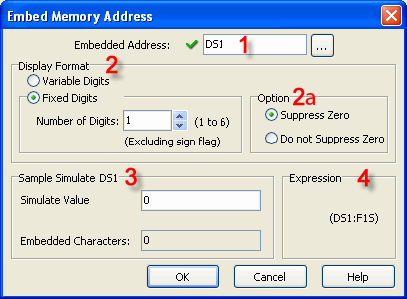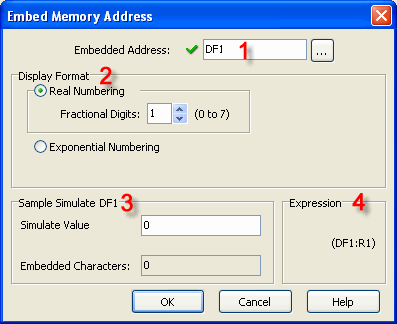Topic: CL151

| Embed Memory Address |
Topic: CL151
|
This dialog is used to Embed a Memory Address in the text message with several formatting options. This dialog has two GUI designs. One design is for the DS, DD, DH, XD, YD, TD, CTD and SD Memory Addresses and the other design is for the DF Memory Addresses.
|
|
Note: You can not Embedded Bit memory addresses (X, Y, C, T, CT and SC) in the text message. |
|
This Setup applies only for the DS, DD, DH, XD, YD, TD, CTD and SD Memory Addresses.

1 Embedded Address: Enter a Memory Address to Embed in the text message or click the Browse Button to open the Address Picker to select a Memory Address from the list.
2 Display Format: Allows you to Set up how the data in the Memory Address is Embedded in the text message.
|
Memory Type |
Least Digits Range |
|
DS, TD, SD |
1 to 5 |
|
DD, CTD |
1 to 10 |
|
DH, XD, YD |
1 to 4 |
2a Option: Allows you to select to Suppress the Zeroes or Not to Suppress the Zeroes. Click to select the desired Option.
|
DS1 = 123 |
|
|
|
Display Format |
Characters in the Text Message (See Note Below) |
Expression |
|
Variable Digits |
"123" |
DS1:V |
|
Fixed Digits, Least Digits = 1, Suppress Zero |
"123" |
DS1:F1S |
|
Fixed Digits, Least Digits = 1, Do not Suppress Zero |
"123" |
DS1:F1 |
|
Fixed Digits, Least Digits = 5, Suppress Zero |
" 123" (Two Space Characters + "123") |
DS1:F5S |
|
Fixed Digits, Least Digits = 5, Do not Suppress Zero |
"00123" |
DS1:F5 |
|
|
Note: Double quotations are not included in the actual text message. |
3 Sample Simulate: Enter a test value in the Simulate Value field. The Embedded Characters field shows what Characters will be Embedded in the text message.
4 Expression: When the Memory Address is Embedded in the text message, one of the following Expression Symbols is attached to the Memory Address with a colon (e.g., DS1:V, DH100:L4.S). This will help when checking the Format Setting in the ladder program.
|
Expression |
Meaning |
|
V |
Variable Digits |
|
FnS |
Fixed Digits, Number of Digits = n, Zero Suppression |
|
Fn |
Fixed Digits, Number of Digits = n, No Zero Suppression |
This Setup applies only for the DFMemory Address

1 Embed Address: Enter a DF Memory Address to Embed in the text message or click the Browse Button to open the Address Picker to select a Memory Address from the list.
2 Display Format: Allows you to Set up the Format between the Real Numbering and the Exponential Numbering. When the Real Numbering is selected, you can specify the number of digits after the decimal point with the Fractional Digits parameter.
|
DF1 = 1.234
|
|
|
|
Digits Setting |
Characters in the Text Message (See Note Below) |
Expression |
|
Real Numbering, Fractional Digits = 0 |
"1" |
DF1:R0 |
|
Real Numbering, Fractional Digits = 4 |
"1.2340" |
DF1:R4 |
|
Real Numbering, Fractional Digits = 7 |
" 1.2340000" |
DF1:R7 |
|
Exponential Numbering |
"1.2340000E+00" |
DF1:E |
|
|
Note: Double quotations are not included in the actual text message. |
3 Sample Simulate: Enter a test value in the Simulate Value field. The Embedded Characters field shows what Characters will be Embedded in the text message.
4 Expression: When the Memory Address is Embedded in the text message, one of the following Expression Symbols is attached to the Memory Address with a colon (e.g., DF1:R4, DF100:E). This will help when checking the Format Setting in the ladder program.
|
Expression |
Meaning |
|
Rn |
Real Numbering, Fractional Digits = n |
|
E |
Exponential Numbering |